Icky, fascinating, and funny—art made from dead bugs.
One way to cultivate creativity is to make art from the mundane. There is tremendous freedom in experimenting with a range of common everyday objects without any preconceived notions. Simply handle the media and reflect on, and then play up, its inherent characteristics. This month’s medium is dead bugs.
Sometimes a dead bug is just a dead bug, but sometimes it is so much more. Bugs have served as a source of inspiration for the literary arts and cinema. The greatest of these may be Charlotte, a compassionate arachnid, a true friend, and a good writer. Bugs have likewise inspired visual artists. In ancient Egypt, Greece, and Rome, scarab beetles were celebrated religious symbols of rebirth and regeneration. And while not as popular a medium as bird feathers and animal horns, hides, and fur, bugs and bug parts have served as a source of artistic expression.
Some have used bugs in a straightforward manner, leveraging their rich array of colors and textures. Others have built on bugs’ ancient religious symbolism to explore themes of memory and resurrection. Artists have found inspiration in bugs’ ewww factor that inspires in many, deep-seated disgust and aversion. While others have viewed bugs as natural wonders, marveling at their abundance and specialized nature and traits. However you view bugs, you will never look at dead bugs the same way again.
- John Hampson’s Bug Art at the Fairbanks Museum in St. Johnsbury, VT obsessively uses the color and textures of thousands of bugs—mostly common field flies and moths—to create quilt patterns and portraits of historic figures.
- Claire Morgan’s Speaking Volumes, Eye, and We All Fall Down suspends thousands of insects to create animated geometric patterns. Installations like Hangover, Hanging Fog, and Down Time create whimsical and poignant tableaux with thousands of insects juxtaposed with life-like taxidermy animals.
- Jan Fabre’s Gravetomb and Skulls installations and Tribute to Belgian Congo use beetle parts and the historical significance of the scarabaeus to explore themes of memory, immortality, and resurrection. In this artist video, Fabre discusses the symbolism of the beetle in his work.
- Enrique Gomez De Molina uses taxidermy to create disturbing chimeras—nightmarish, and sometimes illegal, creatures that blend multiple animal and bug parts. Other sculptures such Rhinoplasty, Crown of Courage, and I am the Walrus use taxidermy forms and iridescent scarab beetle wings.
- Made from desiccated insect remains, dried plant roots, and other organic ephemera, Tessa Farmer’s tiny sculptures give a glimpse into the world of fairies. Elaborate installations like Ambushed by a Mob of Fairies juxtaposes swarms of lifelike insects with art—while others mix bugs and super models.
- Magnus Muhr mixes dead flies and drawings to create comical pictures that poke fun at common everyday activities.
- Jennifer Angus creates repulsive and alluring installations that make textile and wallpaper patterns from bugs pinned directly to the wall.
- Mike Libby’s Insect Lab melds the mechanized and the natural in his surreal bug sculptures http://insectlabstudio.com/
- Lindsey Bessanson riffs on the mechanized insect theme, creating sculptures, clothing and accessories.
- Katie VanBlaricum’s Etsy store celebrates the beauty of insects with her jewelry made from beetles, cicadas, and butterflies https://www.etsy.com/shop/InsectArt?ref=listing-shop-header-item-count
- Fabian Pena uses crushed bugs as a pigment to create paintings that are about using crushed bugs as a pigment.
- Blood Portraits, a Glorix Mosquito Repellent ad campaign uses the blood from squished mosquitoes to paint portraits and inspire blood donations. Watch the video.
- With a twist on the theme, Steven R Kutcher makes painting with bugs, not from bugs. Technically they are not dead bugs, but the pigments can’t be too good for them.
- Steven Spazuk and Danielle Delhaes’ Monarch Project collaborates with butterflies to create works that explore the precariousness of animal and plant life on earth.
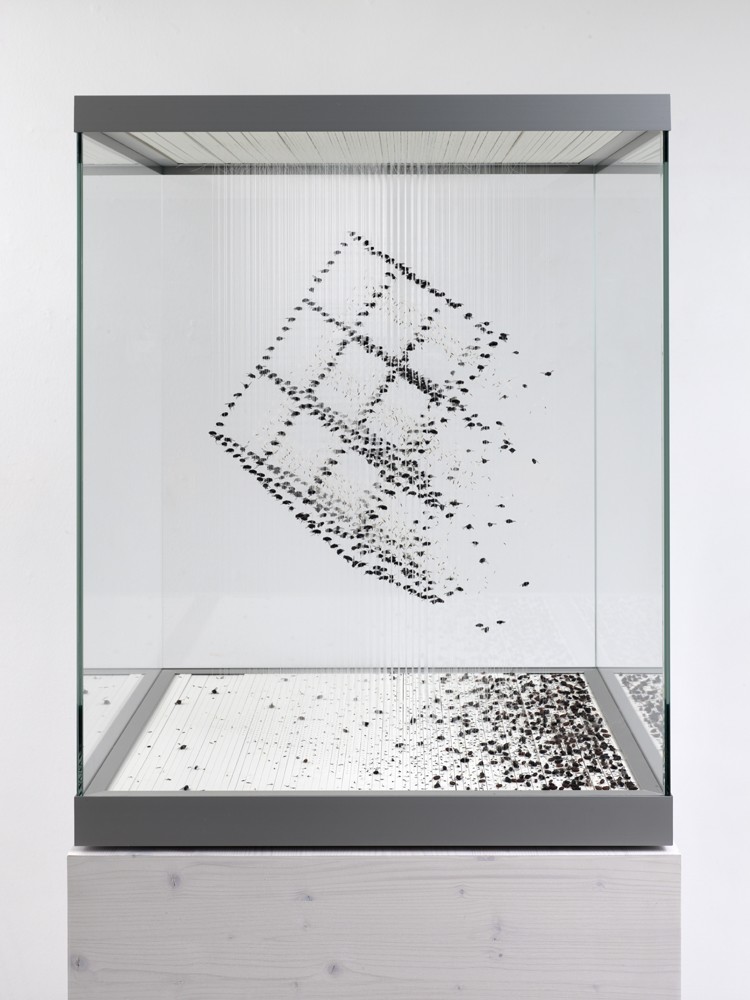
My work is about our relationship with the rest of nature, explored through notions of change, the passing of time, and the transience of everything around us. For me, creating seemingly solid structures or forms from thousands of individually suspended elements has a direct relation with my experience of these forces. There is a sense of fragility and a lack of solidity that carries through all the sculptures. I feel as if they are somewhere between movement and stillness, and thus in possession of a certain energy. Animals, birds and insects have been present in my recent sculptures, and I use suspense to create something akin to freeze frames. In some works, animals might appear to rest, fly or fall through other seemingly solid suspended forms. In other works, insects appear to fly in static formations. The evidence of gravity – or lack of it – inherent in these scenarios is what brings them to life, or death.
— Claire Morgan, from her artist statement, June 2011
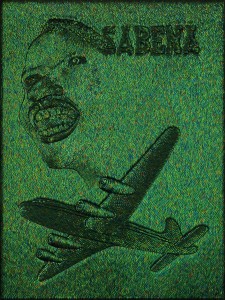
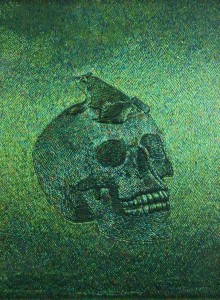

For me the scarabee is a symbol of memory, a symbol of a bridge between life and death…The quality of its color is a very organic color. It is a prismatic color. The color is constantly changing. It is painting with light. It is also a very sensual material because it seduces, very erotical almost. The depth of the color seduces. This is very important because at the same time that its aesthetics attract, then you look inside at the ethical value of the work.
— Jan Fabre, in a video interview with Galerie Daniel Templon
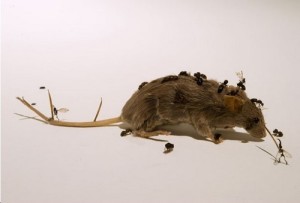

I trawl the streets in summertime, collecting dead insects. Learning about the random materials that I find informs the development of the fairies. I’ve trained my eye to spot dead insects on the streets, and I always carry a container to store them in – empty Tic Tac boxes are good. Friends and family also help me collect. I got married last year (we had an insect-themed wedding) and for gifts we asked for dead stuff or John Lewis vouchers. I received a wonderful bounty of insects, arachnids, skulls and bones. My uncle spent ages taking apart owl pellets to retrieve tiny mouse bones. I also got a shoebox full of dead honeybees, which had been collected in an apiary in Hamburg. Just recently I received an anniversary gift from one of my mum’s friends – a box full of wasps, bees, snail shells and poppy heads! I’m hugely inspired by the natural world, the way insects have evolved and their modes of survival. Often their histories are as horrific as they’re mind-bogglingly incredible. I just love the gory stuff.
— Tessa Farmer, describing her source of supplies and inspiration in an interview with Hayden Kays.


For the past ten years, I have been creating installations composed of insects pinned directly to a wall in repeating patterns which reference both textiles and wallpaper. When viewers enter one of my installations, they are greeted with something they think they know, that is, a patterned wallpaper which could be in anyone’s home. However upon closer examination, one discovers that it is entirely made up of insects. A tension is created by the beauty one observes in the pattern and the apprehension we feel toward insects. I know very few people who welcome insects into their home. In fact, we have a certain hysteria about them. Culturally, insects are a sign of dirtiness and disease. My work explores ideas of home and comfort. It alludes to the unseen world of dust mites, germs and bacteria, both friendly and not.
— Jennifer Angus, from her artist statement
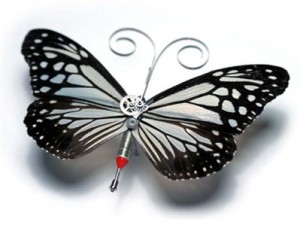

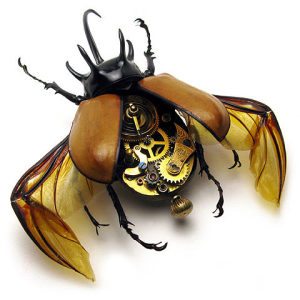
One day I found a dead intact beetle, I then located an old wristwatch, thinking of how the beetle also operated and looked like a little mechanical device and so decided to combine the two. After some time dissecting the beetle and outfitting it with watch parts and gears, I had a convincing little cybernetic sculpture. I soon made many more with other found insects and have been exploring and developing the theme ever since.
— Mike Libby, describing the inspiration for the Insect Lab in an interview in the Daily Mail

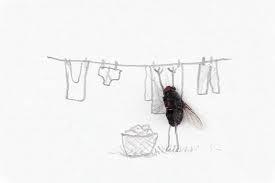
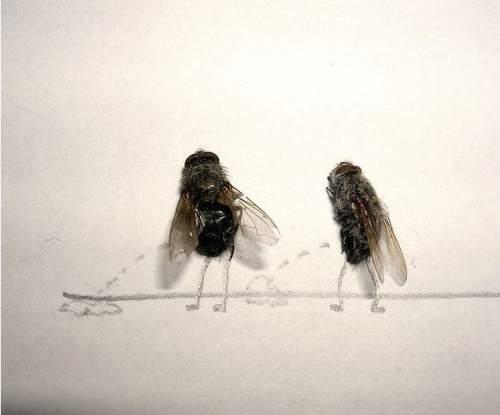
The idea started a few years ago at a party. I was bored and went for a walk, then I found a dead fly on the ground and I immediately came up with the idea. When I got home I put some flies in comic poses on white paper, then drew the legs and background with a pencil and photographed them. I think they’ve become popular as they are very simple and don’t need any text, the language is international and the humour alludes to human feelings and activities.
— Magnus Muhr in an interview in the Daily Mail.com
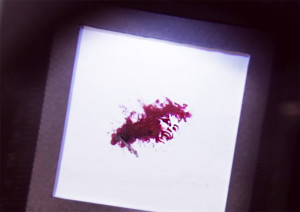
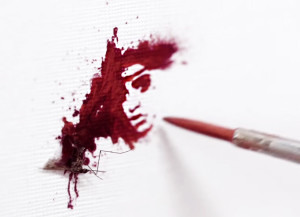
Protect your blood. Donate your blood.
— Blood Portraits, the slogan for the Glorix Mosquito Repellent Ad Campaign by BBDO. See the video.
Add to the discussion by sharing images of your students’ dead bug explorations. Or, please share if you know others who make art from dead bugs.

Thank you for this totally unique medium. I showed everyone in my house!